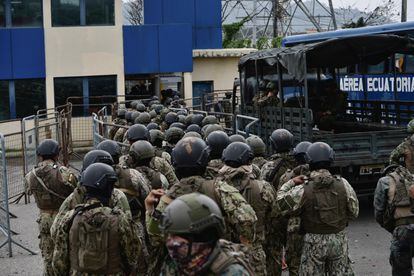The Penitenciaría del Litoral and the Regional correctional facilities, which are both within the same compound, are the most populated prisons in Ecuador. They are located in the coastal city of Guayaquil, and between them they hold 10,000 inmates, more than a quarter of the South American country’s entire prison population. In this place, the convicts are in control. Not only do they run the 15 units inside the prison compound, they also control the drug trafficking and organized crime activities that take place on the outside. It is they who decide who gets to come in and who doesn’t. They even have the keys to their own cells. This is how they have managed to sow terror throughout the country. The latest example took place on Tuesday, when at least 10 people ended up dead, including two police officers.
Seven criminal gangs have been identified that have power within the prisons. In the three units of the Regional, it is Los Choneros who are in charge, and who answer to their boss José Adolfo Macías, aka Fito. In the Penitenciaria, the 12 buildings have been divided up between the Chone Killers, Águilas, Fatales, Latin Kings, Lobos, Tiguerones and the Mafia. It was here that the spark was lit that triggered the first prison massacre on February 23, 2021, where 79 prisoners were beheaded. It was the beginning of a security crisis that has escalated violently, putting up against the ropes Ecuador’s last three governments, none of which have managed to secure control of what happens inside the prisons.
Now, the leaders of the Ecuadorian cartels have challenged the new government of President Daniel Noboa with a wave of attacks that began on Sunday, January 7, when the authorities realized that Fito, the leader of Los Choneros, was missing. Riots erupted in seven prisons.

The layout of the Regional facilities makes it possible to clearly see the movements of the prisoners as they go up and down a wooden staircase to the rooftop, talk on the phone and rest in their hammocks. Anyone passing by on the main road can spot them, as can the police officers and military personnel guarding the first security ring at the entrance. Everything happens in clear view of those who are supposed to be in control.
“Prisons are cities where the prisoners rule,” acknowledged a police officer who has worked in both prisons. “They have their own businesses. In the Regional, from the moment you enter, they offer roast chicken, and there is a food cart selling salchipapa and morocho. These are businesses to feed the structure that they have created inside.”
The obvious question is how the chickens, the food cart, the gas canisters, the weapons, the ammunition, the bombs, the drugs and the alcohol, which have been seized in incalculable amounts, get inside in the first place. The answer is the corruption of a system run by a government agency called SNAI. The Inter-American Commission on Human Rights, which visited the country in 2021, told the government in a document: “Unprecedented corruption within the prisons, as a result of the years-long state neglect of the penitentiary system, as well as the absence of a comprehensive criminal policy,” has led to “self-government,” implying that internal control is exercised by the detainees themselves.
The structure works with a leader for each prison unit who reports to the gang leader. The police officer who explained to EL PAÍS how this corruption network works described that position as that of a “manager.” “Fito, for example, who was in the Regional, did not necessarily know what was going on in one of the pavilions of the Penitenciaria; the leaders of his gang and those affiliated with Los Choneros in each pavilion informed him. He was something like the manager of Los Choneros.”
In each housing unit, the leaders charge for everything. The cells, which measure two by two meters, can hold anywhere from one person to eight or 10, depending on how much they can pay. “If they want a good room, drug traffickers pay up to $1,500 a month; those cells even have air conditioning.” In a cell with two bunk beds for four people, each one might pay around $300 a month. “Whoever didn’t pay slept on the floor,” noted the police source. Such business activities inside one of these housing units might represent as much as $20,000 a month.
Hence, many of the conflicts between criminal gangs are “over the control of the pavilions and penitentiary centers, motivated mainly by economic gains that they could obtain through illicit businesses,” the IACHR warned in its report, adding that the struggle for control and power also takes place outside the prisons.
The model of the Guayaquil prisons was later replicated in the other correctional facilities that are distributed in different parts of the country and under the command of different gangs. Those of Cotopaxi, Quito, Cuenca, Machala, Chimborazo, those that figured prominently in the most recent prison riots, are under the control of Los Lobos, the criminal gang that is trying to achieve hegemonic control over organized crime inside and outside the prisons of Ecuador.
Sign up for our weekly newsletter to get more English-language news coverage from EL PAÍS USA Edition
"control" - Google News
January 10, 2024 at 04:43PM
https://ift.tt/hYFK208
The mafias that control Ecuador from inside their prison cells - EL PAÍS USA
"control" - Google News
https://ift.tt/tvE6oW4
https://ift.tt/Ekfl4iL
Bagikan Berita Ini















0 Response to "The mafias that control Ecuador from inside their prison cells - EL PAÍS USA"
Post a Comment